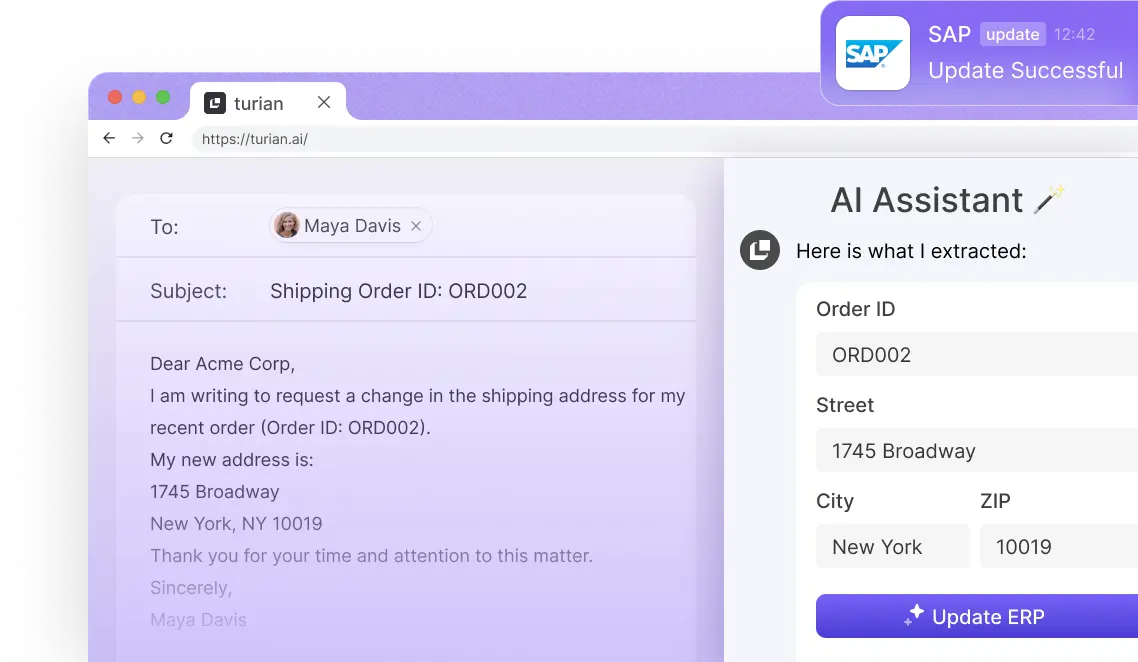

AI Vs Manual Order Processing
In the realm of supply chain management and for any B2B business, order processing is more than a "process." It is the heartbeat of operations. It's the critical link between customers and the fulfillment of their demands. Efficient, accurate, and timely processing means satisfied customers, increased sales, and a healthier bottom line; the opposite can lead to catastrophic outcomes.
There are two primary types of order processing systems: Manual and AI-driven. The traditional process adds a personal touch; it's a human-to-human interaction that feels secure and familiar. On the other hand, AI solutions streamline the entire process, from order entry to fulfillment. So, which method is great for your business? Is AI the future of the order management process?
If you are struggling to discern the differences between manual and AI order processing, you've come to the right place. This comparative guide will walk you through the ins and outs of both processes. By the end, you'll have a clear idea of which system is best for your business needs.
Understanding Order Processing

Image credit: Freepik
Definition and Importance
Order processing, in simple words, is the process or workflow that happens after a customer places an order. It involves all the steps from receiving an order to fulfilling it, which includes tasks like data entry, order confirmation, tracking, and more. For any business that deals with orders and fulfillment (e.g., B2B companies), order processing is a key to success. Here's why this process is so integral:
- It ensures customer satisfaction
- It affects inventory management
- It impacts sales and revenue
- It reflects the brand's image
In short, order processing is the backbone of any business's operations. Its success or standstill can have a monumental impact on the business's bottom line. It is a vital process that requires attention to detail, accuracy, and efficiency to keep the business wheel turning smoothly.
Manual Order Processing: The Old Way To Do Things

Image Credit: Tonodiaz
As the name suggests, manual processing is the traditional, hands-on approach to managing orders. In this method, every step is done by hand without the use of any automation technology. Manual processes depend solely on human skills and personal experience to finish tasks. This process involves physical paperwork, manual data entry into ERP / CRM systems, and communication with customers through emails.
For example, let's say a customer sends an order via email. In a manual process, an employee will have to open the email, read the information, verify it, and then manually enter the data into a spreadsheet or Enterprise Resource Planning (ERP) system. After that, the employee will have to send a confirmation email to the customer and manually update the order status in the system. Traditional methods also have their own perks that can't be ignored or replaced. These include:
- A personal touch that can create customer loyalty
- Ability to handle complex orders or exceptions
- Immediate adaptability to changes or updates
- No need for complex system integration or training
The Downside of Manual Order Processing
While traditional order management systems have their merits, they also come with several (or, should we say, many) downsides. It is a time-consuming, labor-intensive, and error-prone process.
Here are some of the main drawbacks:
1. Increased Risk of Errors
Conventional order processing is highly susceptible to errors. It requires a lot of manual data entry, which can lead to typos, mistakes, and misinterpretation of information. Inaccurate data or delays in processing not only hurt customer satisfaction but also affect inventory management and sales.
2. Time-consuming and Tedious
Manual processes make the entire order management process slow and tedious. Employees have to spend many hours on basic and repetitive tasks like data entry, cross-checking information, and updating systems. It not only adds to the workload but also takes valuable time away from other substantial tasks.
3. Limited Scalability and Efficiency
Human errors are not the only downside of manual order processing. The process itself is not scalable. As a business grows and the volume of orders increases, it becomes hard to manage and process orders manually. It can lead to delays, backlogs, and inefficiencies in fulfilling orders.
4. Lack of Real-Time Visibility
Manual processes are much harder to track and monitor than automated processes because they rely on paperwork, other non-digital methods, or need to be manually supervised in the ERP system. This lack of visibility can create obstacles in decision-making and timely responses to customer inquiries. Without real-time access to critical information, businesses may struggle to keep track of inventory levels, order statuses, and other key data.
The interesting fact: non-autonomous systems like OCR (Optical Character Recognition), RPA (Robotic Process Automation), and EDI (Electronic Data Interchange) are also not immune to these issues.
For instance, while OCR can automate data entry, it still has limitations when dealing with handwritten or unstructured data. RPA can be a quick fix but lacks flexibility and can incur high costs. EDI, while meant to streamline and standardize data exchange, can also be prone to errors and difficult to manage in large volumes.
So, the whole point is that manual processes, in any form, have limitations. It is hard, costly, and error-prone. While it may still work for businesses with low order volumes, it is not a viable option for companies looking to scale and grow.
AI Order Processing: The Future of Order Management

Image Credit: Zinkevych
Process automation or AI-based order processing is a state-of-the-art approach that uses artificial intelligence (AI) technologies to streamline and optimize the order management process. Unlike old-school sales order processes, AI tools use intelligent algorithms and cutting-edge machine learning techniques to automate tedious manual tasks and reduce human error.
From order intake to making updates and sending confirmations, AI-based systems handle all aspects of order processing efficiently and accurately. At the core of the AI order management system are Large Language Models (LLMs). Unlike traditional statistical models (e.g. linear regressions) and supervised Machine Learning (ML) models that are trained on structured data, LLMs are designed to understand, generate, and manipulate human language. They are built on huge amounts of data, which makes them capable of comprehending complex and unstructured information with high accuracy.
But, like manual systems, AI order processing also has its own set of downsides. Below, we've listed some of the major ones:
- Integration with existing, old ERP systems may be difficult
- Employees need training & time to adapt to the new system
- Most core processes are dependent on AI technology
The Benefits of AI Order Processing
Despite these challenges, AI-empowered processes provide a host of benefits that far outweigh their limitations. With AI you're not just automating your business processes, you're also making them faster, more efficient, and accurate. Here are some of the upsides of implementing an AI-based order processing system:

1. Higher Efficiency and Accuracy
One of the main benefits of AI in order processing is its ability to improve accuracy and efficiency while also reducing the risk of human error. AI tools can handle a large volume of orders and data with high speed, accuracy, and consistency. They can also process large amounts of complex or unstructured data better than humans. The result:
- Reduced order processing time
- Lower error rates and fewer delays
- Mitigate business operations cost
It not only eliminates the repetitive tasks from your sales team's shoulders, but it also frees them up to perform more important and strategic tasks, such as customer service, sales strategies, and identifying key trends.
2. Scalability and Flexibility
AI-powered systems not only help with data extraction for efficient and accurate order processing, but they also offer great scalability. As your business grows and order volumes increase, AI systems can easily handle the increased workload without any additional investment. This scalability feature is particularly useful for businesses that experience seasonal fluctuations in demand.
3. Real-time Insights and Analytics
As we said earlier, manual processes take up a lot of time and effort to track and analyze data; it's often too time-consuming to be efficient. But with AI automation, you can get real-time insights and analytics without any manual intervention. It provides a holistic view of your order processing cycle through data visualization and customized reporting. These insights can help you identify areas for improvement and make data-driven decisions to streamline your order management process. It also enables you to better forecast demand and optimize inventory levels to meet customer needs.
4. Improved Customer Experience
The ultimate goal of any business is to provide an exceptional customer experience. With AI-powered order processing, you can achieve this by reducing order processing time, minimizing errors, and providing real-time updates to customers. With advanced tracking and notifications, customers can track their orders in real-time and receive timely updates on their delivery status.
Moreover, AI speeds up your sales order entry process and eliminates potential order errors. Some automation tools also feature smart AI assistant chatbots that can draft and send personalized responses to customer inquiries along with quote generation and order confirmation.
AI vs. Manual Order Processing: Which is Better?

Image Credit: Freepik
Now that we've discussed the benefits and downsides of both manual and AI-based order processing, it's time to answer the million-dollar question: Which is better? Well, the truth is, it depends on your business-specific needs and goals. If you don't have a high volume of orders or if your business processes are relatively simple, manual order processing may work just fine.
Many businesses still rely on manual processing due to budget constraints or because they want to add a personal touch to their customer interactions. However, for businesses with a high volume of orders and complex data requirements, AI-powered order processing is the way to go. It not only saves time and effort but also improves efficiency and accuracy, ultimately leading to higher customer satisfaction. It reduces the risk of human error, provides real-time insights and analytics, and offers scalability for future growth.
It also allows businesses to stay compliant with regulations and offer a seamless customer experience. But, the most significant advantage of AI-based order processing is its ability to constantly learn and improve. As the system processes more orders and data, it becomes smarter and more efficient. It not only reduces the workloads of your sales team but also empowers them to focus on more strategic and critical tasks for the growth of your business. In the end, the decision between manual and AI-based order processing depends on your business needs, but if you want to boost efficiency, accuracy, and customer satisfaction, AI order processing is the best solution for you to consider.
How turian Can Help Streamline Your Order Processing

Image Credit: Dc Studio
Do you often find yourself correcting errors, matching data, and sorting through piles of emails to process orders? It's time to automate your business processes. We know that every second of your team's time is valuable, and that's why we've created turian - the ultimate AI assistant for order processing! Our smart AI assistant is powered by advanced technology and human-like understanding to streamline your business operations and provide an exceptional customer experience.
With turian, there's no need for lengthy model training or complicated integrations. It runs right next to your email inbox and seamlessly integrates with your existing ERP or CRM systems and email clients - all within a few days! From purchase order control and sales entry to compliance management, turian handles it all with ease. It's like having a super-efficient virtual assistant that works 24/7. Our AI assistant is not just a data processor; it also offers a smart feature that can draft and send personalized emails. It saves you time and effort while maintaining the personal touch in your interactions with customers.
It also generates quotes and confirms orders in a matter of seconds. With turian, you can save up to 80% of your team's admin work and utilize that time for more substantial tasks like brainstorming new business strategies or expanding your customer base. Turian is a game-changer for B2B businesses. Not only does it boost efficiency and accuracy, but it also provides real-time insights and analytics to help you make informed business decisions.
Our AI assistant continuously learns and improves as it processes more orders and data, making it smarter and faster each day. But we know that actions speak louder than words, which is why you can book a demo today and experience the power of turian firsthand.
{{cta-block-blog}}

Say hi to your
AI Assistant!


Lernen Sie Ihren KI-Assistenten kennen!
.avif)
FAQ
Artificial Intelligence (AI) is constantly evolving. It has the potential to automate many repetitive tasks involved in manual order processing, such as data entry, sales order validation, quote generation, and compliance management. However, human effort is still crucial for complex decision-making processes and critical cases.
AI can accelerate and redefine operational excellence, but it is not meant to replace human intelligence. It's a tool that can empower businesses to focus on growth while improving efficiency and accuracy.
Turian’s solution for AI-based order processing uses advanced algorithms and techniques to ensure data security. It uses encryption techniques, access controls, and anomaly detection for secure data storage and processing. At Turian, we prioritize data security and follow strict regulations, complying with all required data protections, incl. GDPR, DIN/ISO/IEC 27001 and DIN/ISO/IEC 27018. With our AI assistant, you can trust that your data is safe and secure at all times.
Manual order processing involves a lot of manual work, which increases the risk of human error. Some common errors include data entry mistakes, incorrect product codes or quantities, delays in order processing due to miscommunication or lost emails, and inaccurate fulfillment due to data mismatch.
Yes, AI order processing is scalable for businesses of all sizes. Whether you are a small startup or a large enterprise, Turian can handle your order processing needs efficiently, accurately, and promptly. Our AI assistant uses Large Language Models (LLMs) to process and understand the most complex data. It offers customizable solutions to fit your business requirements and grow alongside your business.





